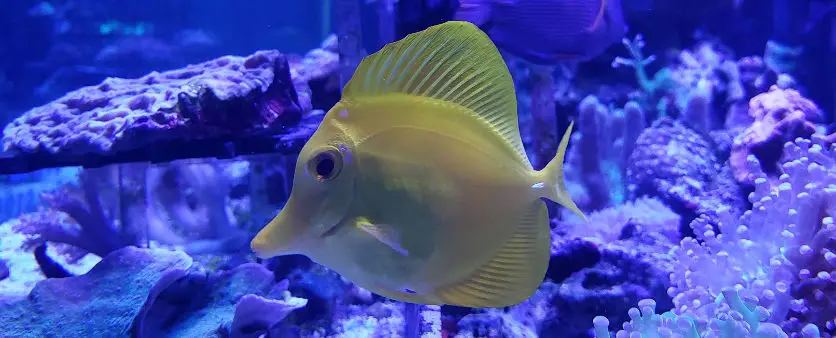Zebrasoma flavescens
| Difficulty | Low |
| Minimum Tank Size | 100 Gallons |
| Diet | Herbivore |
| Water Parameters | 72-78 F, pH 8-8.4, Salinity 1.020-1.025 |
| Aggression | Semi-Aggressive |
| Size | 8" |
Yellow Tangs are one of the most popular choices for new large aquariums. They are fairly easy to care for, easy to feed, they get along with most other fish and are reef safe. Occasionally these fish can be seen harassing new shrimp and crabs, so be sure to add your clean up crew members before the tang. This helps the tang understand they are inhabitants, not food.

Lifetime
The Yellow Tang is fairly hardy, but not as resilient as say a clown. With good care the Yellow Tang can live between 10-20 years. Keeping the tang in a tank that is too small, over crowding the tank and adding too aggressive fish can shorten the tangs lifetime dramatically. If you cannot create the large, open environment the tang needs you can expect between 2-6 years on the tang.
Diet & Feeding
Tangs are mostly herbivores, however they will eat meaty foods along with the rest of the tank. This however should not be their main diet. To maintain a healthy Yellow tang you must offer them seaweed and algae on a regular basis. Supplementing these foods using sea weed clips from amazon is the most reliable way to feed tangs. You can also simply wedge the food between rocks, however this is more likely to disturb your rock structure or be blown away.
Failing to feed the Yellow Tang sufficient greens will result in a weakened immune system, increased aggression and over all poor health. When looking for foods remember that “nori” is simply the Japanese name for edible seaweed, so you don’t need to spend extra on the fancy name. Shop around for the best price, as tangs will always need more food. Check your local Asian grocery store, as this is where I typically find the best prices. Make sure the seaweed has no salt or additives.
When just starting out, feed your Yellow Tang a 1/4th sheet of seaweed/nori a day. If they are picking around the tank, looking for more food increase the amount you are feeding them. While you cannot over feed tangs, they can get costly to feed. Additionally over feeding fish will cause excessive algae and dirty water. Thankfully the tangs will be able to clean up most of this new algae.
Aggression
Yellow Tangs, while typically peaceful in an adequately sized tank, can quickly turn aggressive for multiple reasons. The most common factor in tang aggression is size. Even in a 100 gallon the tang will be on edge. Any other large or intimidating fish will likely be challenged. If you do plan on keeping multiple large fish, a bigger tank will be required.
One of the most common causes of aggression is due to territories. Tangs demand a large space as their home and do not welcome intruders. This happens when we introduce new fish or simply when other fish grow to a more threatening size. To combat this aggression try these steps:
- Remove and quarantine the tang
- Rearrange the tank
- Allow some time for the other fish to establish territories. 2-3 days
- Return the Yellow Tang at night
These are my go to strategies when working with an overly aggressive fish. The idea here is to make every fish besides the Yellow tang established before reintroducing them. This gives them the new fish on the block feel, reducing their territorial tendencies.
Some Yellow tangs however are simply too aggressive for no apparent reason. To combat this you can either place a mirror by the tank or a picture of a Yellow Tang. This will take a lot of the tangs attention, relieving a great deal of aggression that would otherwise be directed towards other fish.
Breeding & Sexing
Learning how to spot the gender of a Yellow Tang is fairly easy. Males will have raised scales behind the scalpels on their tail. Females will be smooth here. Additionally males are larger, making this more easy to spot.
If you wish to keep a pair or more of tangs you will need a much larger tanks. While I have had success in multiple 150 gals most reports show they need a minimum of 180 gallon for 3 tangs. Other wise they will fight over territory. Note: This is only when using one type of tang. Different species will get along much more easily than two of the same.
While breeding yellow tangs in captivity is possible, it requires a massive tank with so much equipment that it just is not possible for the average aquarist. Currently only a few scientific institutes have seen any amount of success.